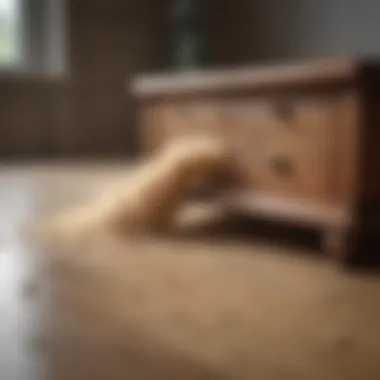Effective Techniques for Dust Removal in Your Home


Intro
Maintaining a clean home is not just about aesthetics; it has significant implications for health and well-being. Dust, a silent intruder, sneaks into our living spaces, settling into every corner and crevice. It comprises a mix of dirt, skin cells, pet dander, and other particulates that can aggravate allergies, asthma, and other respiratory conditions. Thus, understanding how to deal effectively with dust can be a game changer for homeowners and renters alike.
In this guide, we will explore the various sources of dust, practical and effective cleaning techniques, and long-term strategies to keep your living space devoid of these uninvited guests. Getting to the root of the problem not only leads to a cleaner home but also enhances your quality of life.
By implementing the methods outlined here, one can foster a healthier environment that invites comfort and tranquillity into their home. Whether you're a busy parent, a home office worker, or anyone caught in the whirlwind of modern life, these insights may help streamline your cleaning regime, making the task less daunting.
Understanding Dust Accumulation
Dust accumulation in our homes is an often-overlooked aspect of maintaining a clean and healthy living environment. The more we understand dust accumulation, the better equipped we are to tackle it effectively. Dust is not just unsightly; it poses real challenges. Therefore, it’s essential to grasp the fundamental characteristics and behavior of dust in your home.
Dust is composed of various microscopic particles that drift through the air and settle on surfaces. It's not merely an annoyance but a collection of disparate elements, from minute fibers and dead skin cells to pollen and dust mites. Knowing what dust is made of can assist in devising appropriate cleaning strategies.
Another crucial consideration is the effect dust has on indoor air quality. Poor air quality can lead to discomfort and recurrent health issues. For folks with respiratory problems, the implications are even worse. Understanding how and where dust accumulates allows homeowners to focus on prevention strategies.
Dust accumulation can vary based on several factors:
- Location: Homes in urban areas may see different dust sources compared to suburban or rural settings.
- Lifestyle: Pet ownership or having many plants can significantly influence dust levels.
- Home Structure: Older homes often have more nooks and crannies where dust gathers.
Comprehending these aspects sets the groundwork for eliminating dust, leading to a more appealing and health-conscious home. This article will provide guidance on how to approach dust problems, beginning with an understanding of its components, sources, and the potential health impacts associated with its presence.
What Comprises Household Dust?
Household dust is a curious blend of various materials. It typically contains:
- Skin flakes: Humans naturally shed millions of skin cells daily.
- Fibers: These can come from textiles including clothes, carpets, and curtains.
- Pollen: Particularly prevalent during certain seasons, especially for those with gardens or plants indoors.
- Pet dander: If you have furry companions, their skin particles can contribute significantly to dust levels.
- Insect debris: Tiny bits from insects like cockroaches or dust mites can also be mixed in the dust.
- Soil particles: These may enter your home from shoes or through open windows and doors.
The mix creates a complex tapestry of materials, each contributing to dust levels and cleanliness challenges.
Common Sources of Dust in Homes
Understanding where dust originates aids in minimizing its presence. Common sources often include:
- HVAC Systems: As these systems circulate air, they can redistribute dust that has settled and, at times, even blow it back out into living areas.
- Household Items: Cluttered areas, particularly surfaces like shelves or desks, can become dust magnets, retaining particles that settle over time.
- Open Windows: While fresh air is a joy, it can also usher in outdoor dust, pollen, and other particles.
- Foot Traffic: Every time someone walks in and out, they may bring in dirt or debris that contributes to dust buildup.
- Walls and Ceilings: They can gather dust over time, which often gets forgotten as cleaning spots.
Being aware of these sources can significantly change how and when you clean, enabling a more strategic approach to dust management.
The Health Implications of Dust
Dust isn't just a nuisance; it has notable health implications. For many people, common allergens such as dust mites live in household dust and can trigger allergic reactions. Symptoms can range from sneezing and itching to more severe respiratory issues. Those with asthma may find their triggers stemming from dust accumulation.
Additionally, exposure to dust can affect sleep quality. The particles in dust can irritate the airways, causing you to wake up at night, leading to fatigue during the day.
Moreover, dust can also foster a breeding ground for harmful bacteria and mold, exacerbating health issues or leading to illness.


"Dust accumulation is more than just an aesthetic worry, it poses real challenges to our health and well-being."
Initial Assessment
When it comes to maintaining a clean and dust-free home, the initial assessment serves as a pivotal step in your cleaning journey. It sheds light on hidden sources of dust accumulation and helps you identify specific areas that require more attention. By understanding your home dynamics, you can create a targeted plan that focuses on efficient cleaning and long-term dust management. This step is crucial as it allows homeowners to minimize effort while maximizing results.
Identifying Dust-Prone Areas
Every home has its dust hotspots, places where dust tends to settle like an unwelcome guest. These areas vary from room to room and depend on various factors including your type of flooring, furniture, and even the overall layout of your space. To identify these dust-prone zones, you should pay special attention to:
- High surfaces: Shelves, ceiling fans, and light fixtures often accumulate dust due to neglect during regular cleaning.
- Electronics: TVs, computers, and audio systems not only collect dust but can also contribute to poor air quality if not cleaned regularly.
- Under furniture: Chairs, sofas, and beds can gather a significant amount of dust underneath, where cleaning is often overlooked.
- Entryways: Hallways and front doors are magnets for dust, dirt, and debris brought in from outside.
To get a clearer picture, you can perform a visual inspection of your home. Look for dusty surfaces and consider marking them on a floor plan or simply jot them down. Not only does this increase awareness, but it also lays the foundation for an effective cleaning strategy.
Evaluating Your Cleaning Routine
The next step in the initial assessment is to take a hard look at your current cleaning routine. Are you doing enough to keep the dust at bay? Here are a few questions to ponder:
- How often do you dust and vacuum? Regularity is key when it comes to controlling dust. If it’s been a while, it might be time to ramp up your efforts.
- Are you using the right tools? Feather dusters and traditional brooms can stir up dust rather than remove it. Consider investing in microfiber cloths and HEPA-filter vacuums, which can trap particles more effectively.
- Do you engage all family members? A collaborative effort can lead to a cleaner home. Make sure everyone knows their responsibilities when it comes to cleaning.
After evaluating your routine, it might be necessary to adjust your schedule or techniques to make sure all areas are adequately attended to. This not only improves the effectiveness of your cleaning but also promotes a healthier living environment.
"By understanding and addressing your dust problem seriously, you pave the way for a healthier and more pleasant home atmosphere."
In summary, initial assessment provides the groundwork that one can’t afford to overlook. Take time to notice the dust-prone areas in your home and evaluate current cleaning habits. This step will find you on a stronger path to effective dust elimination.
Effective Cleaning Techniques
When it comes to keeping your home dust-free, adopting effective cleaning techniques plays a crucial role. Not only do these methods help minimize the dust accumulation, but they also contribute to a healthier environment. Selecting the right cleaning strategies allows for a more thorough approach and ensures that every surface is attended to, thereby reducing allergens and irritants that can impact everyone’s well-being. Hooking into the right techniques can transform an overwhelming chore into manageable tasks that yield visible results.
Dusting Methodology
Dusting isn’t just about wiping the surfaces clean; it’s about doing so in a way that is most effective. By employing the right methods and tools, you can significantly lessen dust settlement in your home.
Utilizing the Right Tools
Choosing the right tools for dusting makes all the difference. While many may reach for the ordinary feather duster, opting for microfiber cloths or dusters can be considerably more beneficial. Microfiber materials are adept at trapping dust particles rather than just moving them around. Additionally, they do not require harsh chemicals, thereby maintaining the integrity of your furnishings.
- Key Characteristic: The ability of microfiber tools to attract and capture dust effectively.
- Why It’s a Beneficial Choice: Microfiber's fine fibers penetrate crevices where dust likes to hide;
- Unique Feature: Reusable, saving money in the long run, plus they are eco-friendly. However, they do require regular washing to maintain their effectiveness.
Techniques for Various Surfaces
Using the correct technique depending on the surface type is paramount in effective dusting. For example, flat surfaces such as tables and shelves can be wiped in one direction with a microfiber cloth, while textured surfaces like drapes may require a different approach, such as light shaking followed by a gentle vacuum. This tailored approach ensures that no dust is left behind.
- Key Characteristic: Knowing when to use dry dusting or damp dusting based on the surface to avoid scattering dust.
- Why It’s Popular: Customizing your technique maximizes cleanliness and minimizes dust exposure.
- Unique Feature: Specific techniques prove effective for different materials, but it may take some trial and error to understand what works best.
Vacuuming Best Practices


Vacuuming might appear straightforward, but getting it right can be an art. Effective vacuuming entails not just the act of passing a vacuum over your floors, but doing so in a tactful manner that maximizes dust and allergen removal.
Choosing the Right Vacuum
Investing in the right vacuum for your needs can transform your cleaning game entirely. You have the choice of bagged vacuums versus bagless, including those designed specifically to capture pet hair or equipped with HEPA filters that trap minute particles effectively.
- Key Characteristic: Vacuums with HEPA filters can effectively trap allergens, improving home air quality.
- Why It’s Beneficial: Ensures that not only dust but also mildew and other allergens are kept at bay.
- Unique Feature: Different vacuum types come with varied attachments, allowing you to clean upholstery, carpets, and hard floors effectively, though some may be heavier or more complicated to operate.
Vacuuming Frequency and Areas
Establishing a vacuuming schedule is vital in upholding a dust-free home. The more frequently you vacuum, especially in high-traffic areas and spaces with pets or children, the less dust will accumulate.
- Key Characteristic: Regular vacuuming captures dust before it settles.
- Why It’s a Popular Choice: Homeowners often underestimate how often dirt and dust build up in unexpected places.
- Unique Feature: Tailoring your vacuuming frequency based on seasonal changes or renovation work can be essential, yet people usually forget to adjust their routines accordingly.
Mopping Techniques to Remove Dust
After dusting and vacuuming, mopping takes care of dust that settles on hard floors. This step is often overlooked but is crucial for a complete clean.
Types of Mops and Materials
Selecting the right mop impacts your ability to eliminate dust effectively. From traditional mops to modern microfiber options, each offers its unique advantages. Microfiber mops, in particular, trap dust better than traditional sponge mops.
- Key Characteristic: Absorbency and dust-trapping capabilities vary widely among mop types.
- Why It’s Beneficial: Choosing wisely can save time and avoid the frustration of spreading dust rather than cleaning it up.
- Unique Feature: Some mops have detachable heads that can be washed, making them a more sustainable choice, albeit requiring extra steps in care.
Cleaning Solutions to Use
The type of cleaning solution employed can enhance the effectiveness of your mopping efforts. Many prefer utilizing eco-friendly detergents to minimize harsh chemical exposure while still achieving cleanliness.
- Key Characteristic: Some solutions work specifically against dust and allergens.
- Why It’s a Popular Choice: Homeowners tend to lean towards environmentally friendly options that also protect their family’s health.
- Unique Feature: Although many solutions claim effectiveness, not all are compatible with every mop type, requiring careful selection.
Using Air Purifiers Effectively
Air purifiers serve as an additional line of defense in the battle against dust. They continually filter the air and catch dust particles, reducing overall household dust accumulation.
Effective cleaning techniques, encompassing dusting, vacuuming, mopping, and the strategic utility of air purifiers, act collaboratively to ensure your home remains a healthy place. By understanding the nuances of each method, one can not only clean but also keep the air quality high and manage allergens efficiently.
Long-Term Strategies for Dust Prevention
To truly tackle the challenge of dust accumulation, it’s crucial to adopt long-term strategies that prevent dust from infiltrating your home in the first place. Ignoring these strategies might lead to temporary fixes, which can be frustrating and counterproductive. Instead, approaching dust prevention holistically can save you considerable effort down the line. By focusing on your environment and habit changes, you can maintain cleaner and healthier living spaces over time. This section will discuss essential strategies homeowners can implement to fend off dust, keeping their homes fresh and tidy.
Minimizing Dust-Attracting Items
Choosing Furniture Wisely
Choosing the right furniture can greatly influence the amount of dust in your space. Opting for pieces with smooth surfaces and that don’t have too many intricate patterns can make cleaning far easier. For instance, a sleek leather sofa might not trap dust like a fabric one with heavy upholstery. Additionally, streamlined furniture often has fewer nooks and crannies where dust loves to settle.
Bamboo and metal designs are popular, as they resist dust much more than traditional wood options, which sometimes have porous surfaces. Still, remember, it’s not just about the material; it’s about how practical the choice is for your lifestyle. Furniture with removable, washable covers can also be a game changer, as you can clean them easily without worrying about damage.


Assessing Decor Options
Similar to furniture, the decor items you choose can either contribute to or deter dust accumulation. For those who love to showcase decorative pieces, it’s wise to follow certain guidelines. Accessories made from glass or metal tend to require less periodic dusting compared to fabric-heavy decor.
Strategically placed plants can serve a dual purpose: they beautify spaces and can help filter the air. However, ensure they’re not too fluffy—not many dust particles can find refuge there. Consider practical yet elegant items that are easier to maintain. A balance is key; striking the right chord between aesthetic appeal and dust-friendliness ultimately enhances your environment while keeping it cleaner.
Implementing Routine Maintenance
Creating a Cleaning Schedule
Putting a plan into action can work wonders in keeping dust at bay. Creating a cleaning schedule allows you to establish consistency, helping to avoid overwhelming dust build-up during busy periods. Regularity is the name of the game. Consider assigning specific days for certain cleaning tasks; for example, vacuuming on Wednesdays and mopping on Sundays. This creates a structured habit, ensuring that no area is neglected for too long.
Clearly marking rooms that require more routine attention—like bedrooms or living spaces—will help prioritize cleanliness. Incorporating quick daily dusting sessions can also help maintain smoother surfaces. Just taking a few minutes each day can drastically reduce the workload in the long run, making the whole process less daunting.
Educating Household Members
An essential part of maintaining a dust-free home is having every member of the household join in. Educating everyone on the importance of keeping shared spaces clean may cultivate a collective sense of responsibility. It helps to explain how their daily habits can contribute to a cleaner home, discouraging clutter and dust-attracting items.
Practice can be key. Teaching kids to put toys away or reminding adults to keep surfaces clutter-free can create a proactive cleaning culture within the home. When everyone participates in this initiative, it not only simplifies your own cleaning tasks but also fosters a sense of teamwork and shared purpose.
Evaluating Home Air Quality
Regular Check-ups
Evaluating the air quality in your home often escapes notice but is incredibly significant in the fight against dust. Regular check-ups are a proactive measure that can identify issues like excessive humidity, which can increase dust levels and even lead to mold growth. Investing in an air quality monitor can be a wise choice.
Additionally, some homeowners find that routine inspections of HVAC systems help in maintaining air quality. Regularly replacing filters and ensuring vents are dust-free plays a crucial role in trapping dust before it spreads throughout your home. Keeping tabs on air quality identifies potential sources of dust infiltration and provides actionable steps to mitigate them.
Sealing Gaps and Cracks
Another long-term strategy for dust prevention is to seal gaps and cracks around windows and doors. These small crevices can provide easy entry points for dust, pet hair, and other pollutants. Utilizing caulk or weather stripping is a straightforward yet effective method to eliminate these gaps.
By ensuring that your home is tightly sealed, you not only reduce dust but also welcome benefits such as improved energy efficiency and comfort—keeping drafts at bay. However, it’s essential to remember regular checks, as wear over time can create new gaps or cracks and undo all the hard work you’ve put in. Consider reevaluating this every season, especially during extreme weather conditions.
Ending
As we wrap up this extensive exploration of dust elimination in your home, it’s clear that maintaining a dust-free environment is not just about aesthetics; it significantly affects your overall health and well-being. A clean home contributes to improved air quality, reduces allergies, and fosters a more inviting space for family and guests. By implementing the strategies outlined in this article, such as effective cleaning techniques and long-term prevention methods, you can combat dust effectively and keep it from becoming a persistent problem.
Recapping Essential Points
To recap,
- Understanding the Composition of Dust: Recognizing that household dust consists of various particles, such as skin cells, pet dander, and fibers, sets the stage for addressing it effectively.
- Identifying Sources: Knowing where dust comes from, whether it’s furnishings or everyday activities, allows you to target your cleaning efforts more accurately.
- Effective Cleaning: Utilizing tools like microfiber cloths and high-quality vacuums can make a monumental difference in your cleaning routine. Moreover, being consistent with your methods ensures that dust does not accumulate unexpectedly.
- Long-Term Maintenance: By reducing items that attract dust and performing regular maintenance, you can greatly lessen the frequency and intensity of dust buildup in your home.
The Impact of a Dust-Free Environment
Living in a dust-free environment offers several benefits:
- Health Benefits: Lower levels of dust reduce the risk of respiratory issues, allergies, and overall discomfort for inhabitants. This is especially critical for young children and those with existing health concerns.
- Improved Focus and Productivity: Dust can be distracting and affect your mood. A cleaner space often leads to an enhanced mindset and productivity.
- A Welcoming Atmosphere: Whether you are hosting a gathering or simply enjoying a quiet evening, a dust-free home creates a warm, inviting atmosphere for everyone.
"Cleaning your home is not only about eliminating dirt but about creating a space that nurtures health and positivity."
Investing time and effort into dust elimination is not merely a chore; it’s an integral part of cultivating a healthier, happier living space. In the end, it’s about achieving that balance between comfort and cleanliness that makes a house feel like a home.



